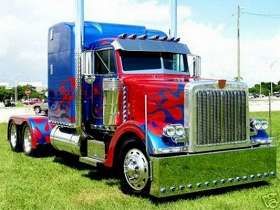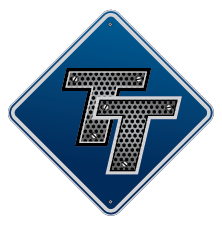Hello, From Kuna, ID/Couple Questions
Topic 23527 | Page 1

I'll answer what I can, I'm still new to all of this.
You get your CDL just like any other driver. Start out or move to flatbed at some point in time. The flatbed company will not run you on oversize or specialized loads at first but you can work up to it over time. These loads are going to pay more and will take more skill and planning so don't expect them until until you have some time in the seat.
CDL:
Commercial Driver's License (CDL)
A CDL is required to drive any of the following vehicles:
- Any combination of vehicles with a gross combined weight rating (GCWR) of 26,001 or more pounds, providing the gross vehicle weight rating (GVWR) of the vehicle being towed is in excess of 10,000 pounds.
- Any single vehicle with a GVWR of 26,001 or more pounds, or any such vehicle towing another not in excess of 10,000 pounds.
- Any vehicle, regardless of size, designed to transport 16 or more persons, including the driver.
- Any vehicle required by federal regulations to be placarded while transporting hazardous materials.
I'll answer what I can, I'm still new to all of this.
You get your CDL just like any other driver. Start out or move to flatbed at some point in time. The flatbed company will not run you on oversize or specialized loads at first but you can work up to it over time. These loads are going to pay more and will take more skill and planning so don't expect them until until you have some time in the seat.
Is flatbed a prerequisite to lowboy? Lowboys seem less dangerous to load because they are so low to the ground. I have read slip and falling hazards are high in flatbed.
CDL:
Commercial Driver's License (CDL)
A CDL is required to drive any of the following vehicles:
- Any combination of vehicles with a gross combined weight rating (GCWR) of 26,001 or more pounds, providing the gross vehicle weight rating (GVWR) of the vehicle being towed is in excess of 10,000 pounds.
- Any single vehicle with a GVWR of 26,001 or more pounds, or any such vehicle towing another not in excess of 10,000 pounds.
- Any vehicle, regardless of size, designed to transport 16 or more persons, including the driver.
- Any vehicle required by federal regulations to be placarded while transporting hazardous materials.
What you are talking about is oversized/heavy haul. They often are more than 80,000 lbs gross. Many are O/O's or work for small companies. It is very specialized and highly skilled driving. Generally you would need a few years of flatbed driving before be able to get into that field. You need to be a safe driver with plenty of securement experience. Don't expect to jump into it. Good luck.
Spoke with one heavy equipment hauler that works with Keen trucking company. It’s not for the faint of heart but the pay is very rewarding. You will need lots of experience to get hired. Something he said that stuck with me is that the securement equipment they is is much stronger than that of a regular flatbedder. Thicker gauge chains means heavier chains. I saw one dude hauling the tracks for a huge tank or heavy equipment. Just the tracks & they hung over the sides of the flatbed so much that he was partly driving in the left break down lane in order to pass us on the right. Yeah, he was moving.
What you are talking about is oversized/heavy haul. They often are more than 80,000 lbs gross. Many are O/O's or work for small companies. It is very specialized and highly skilled driving. Generally you would need a few years of flatbed driving before be able to get into that field. You need to be a safe driver with plenty of securement experience. Don't expect to jump into it. Good luck.
So, probably "journeyman" or "master" level for heavy haul. But why the flatbed experience necessarily? Is a lowboy trailer technically a "flatbed"?
why the flatbed experience
Todd, flat bed experience is where you learn the math and the physics involved in proper and safe load securement. You can't just have some greenhorn beginner pulling a lowboy rig with an oversized 95,000 pound trackhoe on the trailer and expect him to know how many/and or what size chains he needs to properly secure that piece of equipment. Load securement is always the driver's responsibility.
In flatbed work we have to know the WLL (working load limit) of each of our securement devices. You also have to know the WLL of your anchor points. For instance, my 4" nylon straps have a WLL of 5,400 pounds. I am currently loaded with 41,000 pounds of aluminum extrusions. I want my WLL to exceed the working load I'm dealing with by a minimum of 20%. Therefore I need ten straps securing this load of metal. This metal is in varying lengths though, so I need to know how to space my straps so that there are the proper number of straps with the proper spacing also. You cant have two straps with a 14 foot space between them if they are securing the same piece of material - it's not legal. Consequently I needed twelve 4" straps to make this load legal.
There are federal guidelines in the FMCSA "green book" with a multitude of rules and regulations for flatbed work, and all of those and more apply to "Heavy Haul" jobs. Flat bed experience is critical for a person wanting to get into oversized loads. There's no such thing as a dry van or reefer oversized load. All "Heavy Haul" oversized work is flatbed work. It doesn't matter if you have a standard flatbed trailer, a step deck, a RNG, or a lowboy. It's all flatbed work and it all requires considerable knowledge pertaining to making sure that load stays where it belongs as you move it across the country.
We have some excellent training materials on load securement in our High Road CDL Training Program. You should spend some time in their learning about it. You may also enjoy reading this older conversation on this very subject. Perhaps it will help you understand better what I'm talking about. It barely covers the basics, but it should help you realize the great responsibility involved in this type of work.
CDL:
Commercial Driver's License (CDL)
A CDL is required to drive any of the following vehicles:
- Any combination of vehicles with a gross combined weight rating (GCWR) of 26,001 or more pounds, providing the gross vehicle weight rating (GVWR) of the vehicle being towed is in excess of 10,000 pounds.
- Any single vehicle with a GVWR of 26,001 or more pounds, or any such vehicle towing another not in excess of 10,000 pounds.
- Any vehicle, regardless of size, designed to transport 16 or more persons, including the driver.
- Any vehicle required by federal regulations to be placarded while transporting hazardous materials.
CSA:
Compliance, Safety, Accountability (CSA)
The CSA is a Federal Motor Carrier Safety Administration (FMCSA) initiative to improve large truck and bus safety and ultimately reduce crashes, injuries, and fatalities that are related to commercial motor vehicle
FMCSA:
Federal Motor Carrier Safety Administration
The FMCSA was established within the Department of Transportation on January 1, 2000. Their primary mission is to prevent commercial motor vehicle-related fatalities and injuries.
What Does The FMCSA Do?
- Commercial Drivers' Licenses
- Data and Analysis
- Regulatory Compliance and Enforcement
- Research and Technology
- Safety Assistance
- Support and Information Sharing
Fm:
Dispatcher, Fleet Manager, Driver Manager
The primary person a driver communicates with at his/her company. A dispatcher can play many roles, depending on the company's structure. Dispatchers may assign freight, file requests for home time, relay messages between the driver and management, inform customer service of any delays, change appointment times, and report information to the load planners.Dry Van:
A trailer or truck that that requires no special attention, such as refrigeration, that hauls regular palletted, boxed, or floor-loaded freight. The most common type of trailer in trucking.Reefer:
A refrigerated trailer.
HOS:
Hours Of Service
HOS refers to the logbook hours of service regulations.
why the flatbed experience
Todd, flat bed experience is where you learn the math and the physics involved in proper and safe load securement. You can't just have some greenhorn beginner pulling a lowboy rig with an oversized 95,000 pound trackhoe on the trailer and expect him to know how many/and or what size chains he needs to properly secure that piece of equipment. Load securement is always the driver's responsibility.
In flatbed work we have to know the WLL (working load limit) of each of our securement devices. You also have to know the WLL of your anchor points. For instance, my 4" nylon straps have a WLL of 5,400 pounds. I am currently loaded with 41,000 pounds of aluminum extrusions. I want my WLL to exceed the working load I'm dealing with by a minimum of 20%. Therefore I need ten straps securing this load of metal. This metal is in varying lengths though, so I need to know how to space my straps so that there are the proper number of straps with the proper spacing also. You cant have two straps with a 14 foot space between them if they are securing the same piece of material - it's not legal. Consequently I needed twelve 4" straps to make this load legal.
There are federal guidelines in the FMCSA "green book" with a multitude of rules and regulations for flatbed work, and all of those and more apply to "Heavy Haul" jobs. Flat bed experience is critical for a person wanting to get into oversized loads. There's no such thing as a dry van or reefer oversized load. All "Heavy Haul" oversized work is flatbed work. It doesn't matter if you have a standard flatbed trailer, a step deck, a RNG, or a lowboy. It's all flatbed work and it all requires considerable knowledge pertaining to making sure that load stays where it belongs as you move it across the country.
We have some excellent training materials on load securement in our High Road CDL Training Program. You should spend some time in their learning about it. You may also enjoy reading this older conversation on this very subject. Perhaps it will help you understand better what I'm talking about. It barely covers the basics, but it should help you realize the great responsibility involved in this type of work.
Anyway, Old School, I got A's in high-school math so I might be able to handle the numbers-crunching part of it. I do believe in overkill when it comes to securing heavy loads. Civil engineers exercise overkill when designing bridges and dams for a margin of safety. That link to an article I provided in my OP shows that heavy Michigan loader, about 65,000 pounds, that rolled right into the back of the cab of a driver named John when he hit his brakes hard. I think he had four 5,400 pound chains tying down the tractor and that was it. The article said this driver had 22 years experience to boot and the D rings weren't used as they should have been.
I would have to give flatbed work a long thinking over, however, to decide if it's my cup of tea.
It's now apparent to me that one has to master a flatbed before moving into lowboys just as one has to master a propeller airplane before going to jets. Just getting a CDL for a Class 7 or 8 rig for the first time is like getting a pilot's licence for a Cessna trainer using aircraft analogy.
Here's the few things I've heard about flatbed work that makes some drivers gun shy about the thought of doing it:
1. dealing with those heavy, nasty tarps (I don't think a bulldozer has to be covered up for transport on a lowboy) 2. falling off the rig off due to slippery weather (at least if one slips on a lowboy, one won't fall far to the ground)
CDL:
Commercial Driver's License (CDL)
A CDL is required to drive any of the following vehicles:
- Any combination of vehicles with a gross combined weight rating (GCWR) of 26,001 or more pounds, providing the gross vehicle weight rating (GVWR) of the vehicle being towed is in excess of 10,000 pounds.
- Any single vehicle with a GVWR of 26,001 or more pounds, or any such vehicle towing another not in excess of 10,000 pounds.
- Any vehicle, regardless of size, designed to transport 16 or more persons, including the driver.
- Any vehicle required by federal regulations to be placarded while transporting hazardous materials.
CSA:
Compliance, Safety, Accountability (CSA)
The CSA is a Federal Motor Carrier Safety Administration (FMCSA) initiative to improve large truck and bus safety and ultimately reduce crashes, injuries, and fatalities that are related to commercial motor vehicle
FMCSA:
Federal Motor Carrier Safety Administration
The FMCSA was established within the Department of Transportation on January 1, 2000. Their primary mission is to prevent commercial motor vehicle-related fatalities and injuries.
What Does The FMCSA Do?
- Commercial Drivers' Licenses
- Data and Analysis
- Regulatory Compliance and Enforcement
- Research and Technology
- Safety Assistance
- Support and Information Sharing
Fm:
Dispatcher, Fleet Manager, Driver Manager
The primary person a driver communicates with at his/her company. A dispatcher can play many roles, depending on the company's structure. Dispatchers may assign freight, file requests for home time, relay messages between the driver and management, inform customer service of any delays, change appointment times, and report information to the load planners.Dry Van:
A trailer or truck that that requires no special attention, such as refrigeration, that hauls regular palletted, boxed, or floor-loaded freight. The most common type of trailer in trucking.Reefer:
A refrigerated trailer.
HOS:
Hours Of Service
HOS refers to the logbook hours of service regulations.Here's the few things I've heard about flatbed work that makes some drivers gun shy about the thought of doing it:
1. dealing with those heavy, nasty tarps (I don't think a bulldozer has to be covered up for transport on a lowboy) 2. falling off the rig off due to slippery weather (at least if one slips on a lowboy, one won't fall far to the ground)
Todd, forgive my bluntness, but some of the things you say are as comical as they are misinformed. You're worried about falling four feet to the ground off a flatbed trailer, but don't seem to realize how oftentimes heavy haul work involves climbing all over extremely large pieces of equipment to get to the anchor points on them. If it's dead of winter that equipment may be covered in a nice slippery layer of ice. That gets interesting.
If a man's heart can't get into good honest hard work like tarping a flat bed load, I don't know how he could gather the gumption or courage to drive a heavy lowboy with a bulldozer on it up a steep muddy incline on a jobsite.
I once was delivering to a site where the muddy road went right up a mountainside and the construction company had to push my truck and trailer up the Mountain with a bulldozer just to keep me from sliding down the side of the Mountain. Now, that's going to hurt a lot more than slipping off a flatbed trailer, yet heavy haul work involves this kind of danger quite often.
It sounds cool to you, but only in a romantic sense. The reality of the type of work that you seem to think you want to get into is far from your grasp. Trucking is considered one of the top ten most dangerous jobs in the United States, and heavy haul work is some of the most dangerous trucking jobs you'll come across. This stuff takes a lot of heart and Commitment. A big rig hauling an excavator down the road may look really cool to ya, but I promise you that driver paid his dues to be in the driver's seat. He knows what he's doing, and more than likely he learned his craft from a good many years as a flatbed driver.
HOS:
Hours Of Service
HOS refers to the logbook hours of service regulations.
Here's the few things I've heard about flatbed work that makes some drivers gun shy about the thought of doing it:
1. dealing with those heavy, nasty tarps (I don't think a bulldozer has to be covered up for transport on a lowboy) 2. falling off the rig off due to slippery weather (at least if one slips on a lowboy, one won't fall far to the ground)
Todd, forgive my bluntness, but some of the things you say are as comical as they are misinformed. You're worried about falling four feet to the ground off a flatbed trailer, but don't seem to realize how oftentimes heavy haul work involves climbing all over extremely large pieces of equipment to get to the anchor points on them. If it's dead of winter that equipment may be covered in a nice slippery layer of ice. That gets interesting.
If a man's heart can't get into good honest hard work like tarping a flat bed load, I don't know how he could gather the gumption or courage to drive a heavy lowboy with a bulldozer on it up a steep muddy incline on a jobsite.
I once was delivering to a site where the muddy road went right up a mountainside and the construction company had to push my truck and trailer up the Mountain with a bulldozer just to keep me from sliding down the side of the Mountain. Now, that's going to hurt a lot more than slipping off a flatbed trailer, yet heavy haul work involves this kind of danger quite often.
It sounds cool to you, but only in a romantic sense. The reality of the type of work that you seem to think you want to get into is far from your grasp. Trucking is considered one of the top ten most dangerous jobs in the United States, and heavy haul work is some of the most dangerous trucking jobs you'll come across. This stuff takes a lot of heart and Commitment. A big rig hauling an excavator down the road may look really cool to ya, but I promise you that driver paid his dues to be in the driver's seat. He knows what he's doing, and more than likely he learned his craft from a good many years as a flatbed driver.
Well, it proves how much I don't know and what I thought I knew I was very naive about. My impression of heavy-equipment drivers was that they always had escort vehicles and they always traveled on clean paved highways in fair weather. One might think the escort vehicles makes heavy haulers as safe as any baby in mother's arms. Escort fighter planes always make bomber crews feel at ease. I never thought about snow and mud. I figure a lowboy-er would only drive in conditions fair enough to do construction work to begin with. My worst fear for an oversize load driver has always been tunnel and bridge clearances' being too low.
I do know that operating heavy equipment itself is dangerous because my grandfather was a union Operating Engineers heavy equipment operator. He had fallen off a bulldozer twice during his career and broke each arm due to slippery footing while steam cleaning the equipment. I never figured the truck-driving guy sitting in the cab with a D9 dozer or a Hough loader on his rump was in any imminent danger though.
As far as falling off a flatbed, I have heard that guys have to walk on top of the loads sometimes and that can be ten feet or taller above the ground, I believe.
I would think the anchor points for Caterpillar tractors and other earth-movers would be fairly low to the ground.
TWIC:
Transportation Worker Identification Credential
Truck drivers who regularly pick up from or deliver to the shipping ports will often be required to carry a TWIC card.
Your TWIC is a tamper-resistant biometric card which acts as both your identification in secure areas, as well as an indicator of you having passed the necessary security clearance. TWIC cards are valid for five years. The issuance of TWIC cards is overseen by the Transportation Security Administration and the Department of Homeland Security.
HOS:
Hours Of Service
HOS refers to the logbook hours of service regulations.New Reply:
New! Check out our help videos for a better understanding of our forum features

















Preview:








 TT On Facebook
TT On Facebook
Are there any drivers of lowboys for heavy equipment here? How do lowboy drivers start their careers in the United States of America, generally speaking? Often I see these trucks on the highways with yellow OVERSIZE LOAD signs on them and smaller vehicles that escort them. They are loaded with large earth-moving tractors as dozers, excavators, graders, loaders, etc. Do construction contractors usually employ their own drivers and maintain their own fleet of trucks or do independents, O/O and separate companies haul for those in the building trades, road construction and civil engineering?
This facet of commercial trucking is the most fascinating to me because my grandfather was a union Operating Engineer who ran heavy equipment. He worked mainly in road construction, airport runway construction and excavation.
PS - I just found this link this morning that surprised me. I never knew how dangerous lowboy operation can be if heavy loads are not properly secured:
http://www.nationaltruckers.com/blog/ID/9/Truck-Driver-Killed-When-Front-End-Loader-Broke-Free-and-Rolled-onto-Cab
...but even still, this does not discourage my romance for lowboy driving.
Shouldn't the high gooseneck of a lowboy trailer normally protect the driver's cab in the case should a heavy load break loose and shift or roll forward anyway? Might a sleeper cab have saved the life of driver John in that article link above? He only had a day cab and it seems he had little protection from that heavy loader that rolled forward and penetrated his cab.
Day Cab:
A tractor which does not have a sleeper berth attached to it. Normally used for local routes where drivers go home every night.
HOS:
Hours Of Service
HOS refers to the logbook hours of service regulations.OOS:
When a violation by either a driver or company is confirmed, an out-of-service order removes either the driver or the vehicle from the roadway until the violation is corrected.